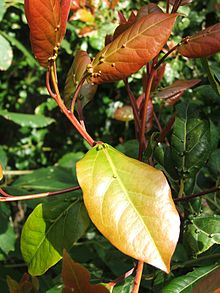- Ocotea bullata
-
Ocotea bullata Conservation status Scientific classification Kingdom: Plantae (unranked): Angiosperms (unranked): Magnoliids Order: Laurales Family: Lauraceae Genus: Ocotea Species: O. bullata Binomial name Ocotea bullata
(Burch.) Baill.Ocotea bullata (Black Stinkwood) is a species of flowering tree in the family Lauraceae, native to South Africa. It produces very fine and valuable timber which, along with Yellowood, was much sought after to make traditional furniture. Due to over-exploitation it is now a protected species.
Other names for it are Cape Walnut, Stinkhout, Cape Laurel and Laurel wood. It derives its name from having a strong smell when fresh felled.Contents
Appearance
It is a large, evergreen tree, that grows up to 30 m tall. The leaves are dark green and glossy, with bubbles (bullae) produced on the upper surface of the leaves, hence the specific name bullata.
The flowers are often dioecious.Distribution
This tree is indigenous to the high forests of South Africa, from Table Mountain in the south, to the afro-montane forests of Limpopo in the north.
It has been effectively exterminated on the slopes of Table Mountain where it has been felled for timber and replaced by invasive Pine plantations. It is also frequently and fatally stripped of its bark, which is taken for use in traditional medicine. Consequently it is now a Protected Tree in South Africa.Growing Ocotea bullata
Ocotea bullata can be a very impressive tree for a larger garden or park. Care must be taken with their planting and they prefer a shady position but, once established, they are quite fast growing.
Stinkwood trees can be propagated with some difficulty from cuttings. It can also be grown from seed, which must be freshly picked, cleaned and planted immediately. Germination takes around 30 days.Uses
The tree yields a beautiful timber much prized by cabinet-makers. The wood is dark walnut or reddish brown to black with a yellow sap-wood, and the grain extremely fine, close, dense and smooth. It is said to be as durable as teak. The tree is badly overexploited and the wood is no longer available commercially.
It is one of the most popular plants traded for traditional medicine in South Africa, mainly for its perceived effectiveness in treating urinary diseases.References
- article from Veld & Flora
- "Ocotea bullata". Plantz Afrika. http://www.plantzafrica.com/plantnop/ocoteabull.htm. Retrieved 2010-02-04.
- Protected Trees in South Africa
- van Wyk, B. and van Wyk, P. 1997. Field Guide to trees of South Africa. Struik, Cape Town
Categories:- IUCN Red List endangered species
- Ocotea
- Flora of South Africa
- Trees of South Africa
- Protected Trees of South Africa
- Trees of Cape Town
- Afromontane
- Laurales stubs
- Tree stubs
Wikimedia Foundation. 2010.



